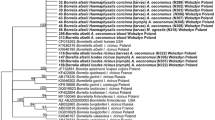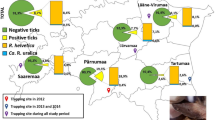Abstract
Introduced Siberian chipmunks Eutamias sibiricus have been reported to be important reservoirs for human Lyme disease, as they may host high numbers of hard ticks carrying Borrelia spp. and other pathogens. In the present study, we assessed the prevalence of Borrelia spp. and other pathogenic bacteria in ectoparasite arthropod species infesting Siberian chipmunks and coexisting native small rodents. Small rodents were trapped with Sherman traps in Veneto (NE Italy), where the largest Italian populations of chipmunks occur. A total of 14 individual ticks were found on 223 rodents, with 6 more ticks obtained from stored dead chipmunks from the same study area. Ectoparasites were screened for pathogens by molecular analyses including species-specific PCR amplifications. Rickettsia monacensis, Borrelia lusitaniae, and Anaplasma platys were present in the parasites of both native rodents and introduced chipmunks. The present findings suggest a role for the invasive species E. sibiricus in the maintenance of the Ixodes ricinus life cycle, which may result in the modification of the transmission dynamics of tick-borne pathogens. Moreover, the presence of Rickettsia in urban populations of chipmunks may represent a serious risk for human health and should be investigated further.

Similar content being viewed by others
References
Aljanabi SM, Martinez I (1997) Universal and rapid salt-extraction of high quality genomic DNA for PCR-based techniques. Nucleic Acids Res 25:4692–4693
Ancillotto L, Mori E, Sozio G, Solano E, Bertolino S, Russo D (2016) A novel approach to field identification of cryptic Apodemus wood mice: calls differ more than morphology. Mammal Rev 47:6–10
Chu CY, Jiang BG, Liu W, Zhao QM, Wu XM, Zhang PH, Zhan L, Yang H, Cao WC (2008) Presence of pathogenic Borrelia burgdorferi sensu lato in ticks and rodents in Zhejiang, south-east China. J Med Microbiol 57:980–985
Daszak P, Cunningham AA, Hyatt AD (2000) Emerging infectious diseases of wildlife– threats to biodiversity and human health. Science 287:443–449
Debernardi P, Patriarca E, Reutter BA (2003) Contribution to the knowledge of Apodemus genus in the Gran Paradiso National Park. Hystrix 14:55–75
Dunn AM (2009) Parasites and biological invasions. Adv Parasitol 68:161–184
Guglielmone AA, Robbins RG, Apanaskevich DA, Petney TN, Estrada-Peña A, Horak IG, Shao R, Barker SC (2010) The Argasidae Ixodidae and Nuttalliellidae (Acari: Ixodida) of the world: a list of valid species names. Zootaxa 2528:1–28
Hersh MH, Ostfeld RS, McHenry DJ, Tibbetts M, Brunner JL, Killilea ME, LoGiudice K, Schmidt KA, Keesing F (2014) Co-infection of blacklegged ticks with Babesia microti and Borrelia burgdorferi is higher than expected and acquired from small mammal hosts. PLoS One 9:e99348
Hubàlek Z, Halouzka J (1997) Distribution of Borrelia burgdorferi sensu lato genomic groups in Europe, a review. Eur J Epidemiol 13:951–957
Iatta R, Immediato D, Puttilli MR, Danesi P, Passantino G, Parisi A, Mallia E, Otranto D, Cafarchia C (2015) Cryptococcus neoformans in the respiratory tract of squirrels, Callosciurus finlaysonii (Rodentia, Sciuridae). Med Mycol 53:666–673
Kelly DW, Paterson RA, Townsend CR, Poulin R, Tompkins DM (2009) Parasite spillback: a neglected concept in invasion ecology? Ecology 90:2047–2056
Kilpatrick HJ, Labonte AM, Stafford KC (2014) The relationship between deer density, tick abundance, and human cases of Lyme disease in a residential community. J Med Entomol 57:777–784
Le Cœur C, Chantepie S, Pisanu B, Chapuis JL, Robert A (2016) Inter-annual and inter-individual variations in survival exhibit strong seasonality in a hibernating rodent. Oecologia 181:795–807
Mack RN, Simberloff D, Lonsdale WM, Evans H, Clout M, Bazzaz FA (2000) Biotic invasions: causes, epidemiology, global consequences, and control. Ecol Appl 10:689–710
Madeddu G, Mancini F, Caddeo A, Ciervo A, Babudieri S, Maida I, Fiori ML, Rezza G, Mura MS (2012) Rickettsia monacensis as cause of Mediterranean spotted fever-like illness, Italy. Emerg Infect Dis 18:702–704
Marmet J, Pisanu B, Chapuis JL (2009) Home range, range overlap, and site fidelity of introduced Siberian chipmunks in a suburban French forest. Eur J Wildl Res 55:497–504
Marsot M, Sigaud M, Chapuis JL, Ferquel E, Cornet M, Vourc’h G (2011) Introduced Siberian chipmunks (Tamias sibiricus barberi) harbor more-diverse Borrelia burgdorferi sensu lato genospecies than native bank voles (Myodes glareolus). Appl Environ Microbiol 77:5716–5721
Marsot M, Chapuis JL, Gasqui P, Dozières A, Massèglia S, Pisanu B, Ferquel E, Vourc’h G (2013) Introduced Siberian chipmunks (Tamias sibiricus barberi) contribute more to Lyme borreliosis risk than native reservoir rodents. PLoS One 8:e55377
Martinez R, Morato S (2004) Thigmotaxis and exploration in adult and pup rats. Rev Etol 6:49–54
Massung RF, Slater K, Owens JH, Nicholson WL, Mather TN, Solberg VB, Olson JG (1998) Nested PCR assay for detection of granulocytic Ehrlichiae. J Clin Microbiol 36:1090–1095
Mazza G, Tricarico E, Genovesi P, Gherardi F (2014) Biological invaders are threats to human health: an overview. Ethol Ecol Evol 26:112–129
Mazzamuto MV, Pisanu B, Romeo C, Ferrari N, Preatoni D, Wauters LA, Chapuis JL, Martinoli A (2016) Poor parasite community of an invasive alien species: macroparasites of Pallas’s squirrel in Italy. Ann Zool Fenn 53:103–112
Michaux JR, Kinet S, Filippucci MG, Libois R, Besnard A, Catzeflis F (2001) Molecular identification of three sympatric species of wood mice (Apodemus sylvaticus, A. flavicollis, A. alpicola) in western Europe (Muridae: Rodentia). Mol Ecol Notes 1:260–263
Millins C, Gilbert L, Medlock J, Hansford K, Thompson DB, Biek R (2017) Effects of conservation management of landscapes and vertebrate communities on Lyme borreliosis risk in the United Kingdom. Philos Trans R Soc B 372:20160123
Morganti G, Gavaudan S, Canonico C, Ravagnan S, Olivieri E, Diaferia M, Marenzoni ML, Antognoni MT, Capelli G, Silaghi C, Veronesi F (2017) Molecular survey on Rickettsia spp., Anaplasma phagocytophilum, Borrelia burgdorferi sensu lato, and Babesia spp. in Ixodes ricinus ticks infesting dogs in Central Italy. Vector Borne Zoonotic Dis 17:743–747
Mori E, Zozzoli R, Menchetti M (2018) Global distribution and status of introduced Siberian chipmunks Eutamias sibiricus. Mammal Rev 48:139–152
Nentwig W, Bacher S, Kumschick S, Pyšek P, Vilà M (2018) More than “100 worst” alien species in Europe. Biol Invasions 6:1611–1621
Pajoro M, Pistone D, Varotto Boccazzi I, Mereghetti V, Bandi C, Fabbi M, Scattorin F, Sassera D, Montagna M (2018) Molecular screening for bacterial pathogens in ticks (Ixodes ricinus) collected on migratory birds captured in Northern Italy. Folia Parasitol in press, 65
Parola P, Paddock CD, Socolovschi C, Labruna MB, Mediannikov O, Kernif T, Abdad MY, Stenos J, Bitam I, Fournier PE, Raoult D (2013) Update on tick-borne rickettsioses around the world: a geographic approach. Clin Microbiol Rev 26:657–702
Pérez-Eid C (2007) Les tiques: identification, biologie, importance médicale et vétérinaire. Lavoisier Editions, Paris
Pisanu B, Marsot M, Marmet J, Chapuis JL, Rèale D, Vourc’h G (2010) Introduced Siberian chipmunks are more heavily infested by ixodid ticks than are native bank voles in a suburban forest in France. Int J Parasitol 40:1277–1283
Prediger J, Horčičková M, Hofmannová L, Sak B, Ferrari N, Mazzamuto MV, Romeo C, Wauters LA, McEvoy J, Kváč M (2017) Native and introduced squirrels in Italy host different Cryptosporidium spp. Eur J Protistol 61:64–75
Prenter J, MacNeil C, Dick JT, Dunn AM (2004) Roles of parasites in animal invasions. Trends Ecol Evol 19:385–390
Price PW, Westoby M, Rice B, Atsatt PR, Fritz RS, Thompson JN, Mobley K (1986) Parasite mediation in ecological interactions. Annu Rev Ecol Syst 17:487–505
Ragagli C, Mannelli A, Ambrogi C, Bisanzio D, Ceballos LA, Grego E, Martello E, Selmi M, Tomassone L (2016) Presence of host-seeking Ixodes ricinus and their infection with Borrelia burgdorferi sensu lato in the Northern Apennines, Italy. Exp Appl Acarol 69:167–178
Rizzoli A, Silaghi C, Obiegala A, Rudolf I, Hubálek Z, Földvári G, Plantard O, Vayssier-Taussat M, Bonnet S, Spitalskà E, Kazimírová M (2014) Ixodes ricinus and its transmitted pathogens in urban and peri-urban areas in Europe: new hazards and relevance for public health. Front Public Health 2:251
Romeo C, Wauters LA, Ferrari N, Lanfranchi P, Martinoli A, Pisanu B, Preatoni DG, Saino N (2014) Macroparasite fauna of alien grey squirrels (Sciurus carolinensis): composition, variability and implications for native species. PLoS One 9:e88002
Roux V, Rydkina LE, Eremeeva M, Raoult D (1997) Citrate synthase gene comparison, a new tool for phylogenetic analysis, and its application for the Rickettsiae? Int J Syst Bacteriol 47:252–261
Sonè K, Tojo H (1993) Trapping capabilities of two live-traps used on two species of field mice, Apodemus speciosus and A. argenteus. Appl Entomol Zool 28:537–545
Thomas K, Tompkins DM, Sainsbury AW, Wood AR, Dalziel R, Nettleton PF, McInnes CJ (2003) A novel poxvirus lethal to red squirrels (Sciurus vulgaris). J Gen Viroly 84:3337–3341
Vourc’h G, Marmet J, Chassagne M, Bord S, Chapuis JL (2007) Borrelia burgdorferi sensu lato in Siberian chipmunks (Tamias sibiricus) introduced in suburban forests in France. Vector Borne Zoonotic Dis 7:637–641
Welch JN, Leppanen C (2017) The threat of invasive species to bats: a review. Mammal Rev 47:277–290
Zozzoli R, Menchetti M, Mori E (2018) Spatial behaviour of an overlooked alien squirrel: the case of Siberian chipmunks Eutamias sibiricus. Behav Process 153:107–111
Acknowledgements
We would like to thank the following (in alphabetical order): Alvise Camurri-Piloni, Jean-Louis Chapuis, Mauro Bon, Michele Cassol, Luca Lapini, Andrey Lissovsky, Mattia Menchetti, Ekaterina Obolenskaya, Giuseppe Tormen, and Arianna Spada who provided us with useful information to set our survey at best. We are deeply indebted with Prof. Danilo Russo (University of Naples Federico II), who provided us with the Sherman traps. Alberto Camporesi, Fabio Dartora, Andrea Vendramin, and Marta Villa helped us during our field work. Riccardo Castiglia (University of Roma “La Sapienza”) made available the genetic analyses facilities. EM was funded by the “Giuseppe Guelfi” Grant of the Accademia Nazionale dei Lincei (Roma, Italy). Prof. Jean-Claude Beaucournu kindly helped us for flea identification. Dr. Vasco Sfondrini kindly revised the first version of our manuscript and improved the English grammar and syntax. Two anonymous reviewers and the editor of provided us with useful comments, which greatly improved our manuscript.
Author information
Authors and Affiliations
Corresponding author
Ethics declarations
All applicable international, national, and/or institutional guidelines for the care and use of animals were followed. Ethical approval was provided within the ISPRA permission (ISPRA, prot. 24128/T-A31).
Conflict of interest
The authors declare that they have no conflict of interest.
Additional information
Section Editor: Boris R. Krasnov
Electronic supplementary material
ESM 1
(DOCX 77 kb)
Rights and permissions
About this article
Cite this article
Mori, E., Pisanu, B., Zozzoli, R. et al. Arthropods and associated pathogens from native and introduced rodents in Northeastern Italy. Parasitol Res 117, 3237–3243 (2018). https://doi.org/10.1007/s00436-018-6022-4
Received:
Accepted:
Published:
Issue Date:
DOI: https://doi.org/10.1007/s00436-018-6022-4




